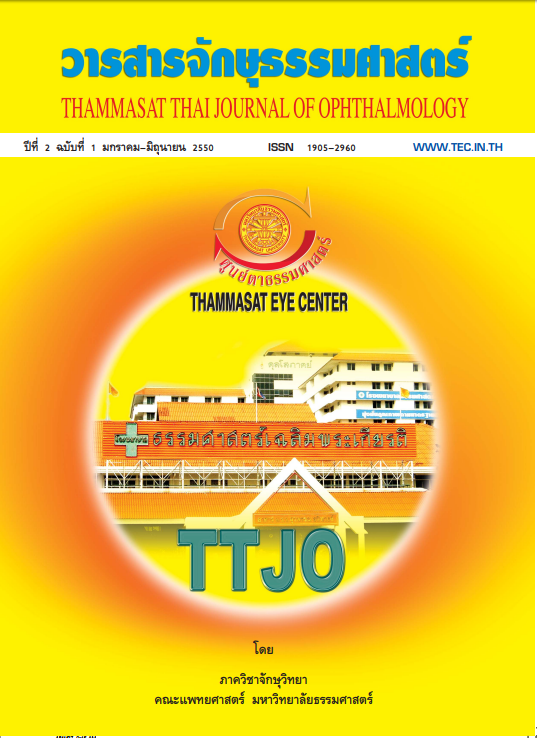อุบัติเหตุลูกตาแตก และท่อน้ำตาขาดในโรงพยาบาลธรรมศาสตร์เฉลิมพระเกียรติ
Main Article Content
Abstract
วัตถุประสงค์: เพื่อศึกษาข้อมูลพื้นฐานและอุบัติการณ์ของผู้ป่วยที่ได้รับอุบัติเหตุที่ตาชนิดลูกตาแตก (open globe injury) และเปลือกตา-ท่อน้ำตาฉีกขาด (eyelid-lacrimal laceration) ในโณงพยาบาลธรรมศาสตร์เฉลิมพระเกียรติ ตั้งแต่มกราคม 2548- ธันวาคม 2549
แบบวิจัย: การวิจัยเชิงพรรณนาแบบย้อนหลัง
วิธีการศึกษา: ศึกษาข้อมูลผู้ป่วยอุบัติเหตุที่ตา ประเภทผู้ป่วยในของโรงพยาบาลธรรมศาสตร์เฉลิมพระเกียรติตั้งแต่ มกราคม 2548-ธันวาคม 2549 จำนวน 100 ราย เป็นผู้ป่วยลูกตาแตก 38 ราย และเปลือกตา-ท่อน้ำตาฉีกขาด 16 รายตามลำดับ โดยศึกษาถึงอายุ เพศ สาเหตุของอุบัติเหตุ ภาวะแทรกซ้อนของอุบัติเหตุ และค่าระดับสายตาก่อนและหลังการรักษา
ผลการวิจัย: มีผู้ป่วยอุบัติการณ์ลูกตาแตกและเปลือกตา-ท่อน้ำตาฉีกขาด คิดเป็น 38 ราย (38%) และ 16 ราย (16%) ตามลำดับ เป็นเพศชาย 48 ราย (96%) เพศหญิง 2 ราย (4%) ซึ่งมีความสัมพันธ์กันอย่างมีนัยสำคัญทางสถิติ (p = 0.027) อายุเฉลี่ย 36.30 ปี เพศชายเฉลี่ย 36.87 ปี เพศหญิงเฉลี่ย 22.50 ปี มีสาเหตุของอุบัติเหตุอันดับหนึ่ง เนื่องจากการทำงาน 20 ราย (40%) ภาวะแทรกซ้อนที่พบมากที่สุดคือ มีเลือดออกที่ช่องหน้าลูกตา 16 ราย (42.10%) ค่าระดับสายตา มีระดับการมองเห็นน้อยกว่า 20/200 จำนวน 21 ราย (55.26%) มองไม่เห็นไฟ 6 ราย (15.78%) เศษเหล็กในลูกตา (metallic foreign bodies) 2 ราย (5.26%) มีความรุนแรงถึงขั้นลูกตาติดเชื้อ (endophthalmitis) 3 ราย และหลังการผ่าตัดเย็บซ่อมลูกตามีการอักเสบติดเชื้อรุนแรง เป็นเหตุให้ต้องผ่าตัดลูกตาออก 2 ราย (5.20%)
สรุป: ผู้ป่วยอุบัติเหตุที่ตาในโรงพยาบาลธรรมศาสตร์เฉลิมพระเกียรติ เป็นชายถึง 96% และอยู่ในวัยทำงาน มีสาเหตุจากทำงานมากที่สุด มากกว่าร้อยละ 50 ที่มีค่าระดับสายตามีระดับการมองเห็นต่ำกว่าเกณฑ์ปกติ (น้อยกว่า 20/200) การป้องกันและรักษาอย่างถูกต้องของภาวะฉุกเฉินอุบัติเหตุที่ตาจึงเป็นมาตรการที่ต้องตระหนักและให้ความสนใจมากขึ้น เพื่อให้การรักษาได้ถูกต้องและเหมาะสม อาจสามารถรักษาการมองเห็นของผู้ป่วยไว้ได้
--------------------------------------------------
Objective: To study the incidence of open globe injuries and eyelid-lacrimal lacerations following ocular injuries in between January 2005 and December 2006 in Thammasat Hospital, Patumthani, Thailand.
Study designs: Retrospective descriptive study
Methods: There were 100 hospitalized patients in Thammasat Hospital for eye injuries in between January 1st, 2005 and December 31st, 2006. Thirty-eight cases of open globe injuries and 16 cases of eyelid lacerations were statistically analyzed age, gender, cause of injury, type of injury, complication of the injury, initial visual acuity and end result, intraocular foreign body and other factors (alcohol).
Results: There were 38 cases (38%) of open globe injuries and 16 cases (16%) of eyelid-lacrimal lacerations, related with 48 men (96%) men and 2 women (4%) in statistically significant (p = 0.027). Mean patients age was 36.30 years (men 36.87 years, women 22.50 years). Twenty cases (40%) of eye injuries happened at worksite. The most common complications were traumatic hyphema 16 cases (42.10%). The initial visual acuity was less than 20/200 in 55.26% cases and 15.78% was no light perception. There were 5.26% of intraocular metallic foreign bodies and 5.26% were enucleated because of severe uncontrolled endophthalmitis.
Conclusions: Most of the eye injuries affected young males and occurred at workplace. More than one half of the patients had severe visual loss from eye injuries. Providing eye health education for the worker may decrease the incidence and improve visual prognosis of ocular injury at the workplace.
Article Details
References
Negrel AD, Thylefors B. The global impact of the eye injuries. Ophthalmic Epidemiol 1998; 5:143-69.
Schein OD, Hibberd PL, Shingleton BJ, Kunzweiler T, Frambach DA, Seddon JM, et al. The sectrum and burden of ocular injury. Ophthalmology 1988; 95:300-5.
Kuhn F, Morris R, Witherspoon CD, Heimann K, Jeffers J, Treister G. Standardized classification of ocular trauma terminology. Ophthalmology 1996; 103:240-3.
โกศล คำพิทักษ์. อุบัติเหตุทางตาในโรงพยาบาลธรรมศาสตร์เฉลิมพระเกียรติ จักษุสาธารณสุข 2543; 14(1):19-24.
Kuhn F, Mester V, Berta A, Morris R. Epidemiology of severe eye injuries. United States Eye Injury Registry (USEIR) and Hungarian Eye Injury Registry. Ophthalmology 1998 May; 95(5):332-43.
Pieramici DJ, Sternberg P Jr, Aaberg TM Sr, Bridges WZ Jr, Capone A Jr, Cardillo JA, et al. A system for classifying mechanical injuries of the eyes (globe). Am J Ophthalmol 1997; 123:820-31.
ทัศพร ตั้งกิจโชติ. การบาดเจ็บที่ตาในโรงพยาบาลแม่สอด วาสารวิชาการแพทย์ เขต 8 2539, พ.ค.-ส.ค.11-20
สุนีย์ ธีรการุณวงศ์. อุบัติเหตุทางตาในโณงพยาบาลส่วนภูมิภาค, จักษุสาธารณสุข 2543; 14(2):229-36.
ณัฐวัฒน์ วงษ์ไชยคุณากร, อนุชิต กิจธารทอง. การประเมินภาวะอุบัติหตุทางตาโดยใช้ Ocular trauma score ในโรงพยาบาลสงขลานครินทร์ สงขลานครินทร์เวชสาร ปีที่ 23 ฉบับที่ 2 มี.ค.-เม.ย. 2548:99-109.
Gothwal VK, Adolph S, Jalali S, Naduvilath TJ. Demography and prognostic factors of ocular injures in South India. Aust N Z J Ophthalmol.1999 Oct; 27:318-25.
Mela EK, Gerogakopoulos CD, Ceorgalis A, Koliopoulos JX, Gartaganis SP. Severe ocular injuries in Greek children. Ophthalmic Epidemiol. 1003 Feb; 10;23-9.
Thompson, C.G. Kumar N, Billsn FA, Martin F. The aetiology of perforation ocular injuries in children. Br J Ophthalmol 2002 ; 86 ; 920-22.
Behbehami AM, Lotfy N, Ezzdean H, Albader S, Kamel M, Abul N. Open eye injuries in the pediatric population in Kuwait. Med Princ Pract. 2002 Oct-Dec; 11;183-9.
Adeoye AO. Eye injuries in the young in, Nigeria. Niger J Med. 2002 Jan-Mar; 11; 26-9.
Saxena R.Sinha R, Purohit Am, Dada T. Vajpayee RB, AzadRV. Pattern of pediatric ocular trauma in India. Indian J Pediatr 2002 (Oct); 69;863-7.


